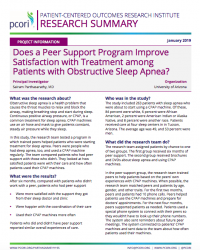Does a Peer Support Program Improve Satisfaction with Treatment among Patients with Obstructive Sleep Apnea?

What was the research about?
Obstructive sleep apnea is a health problem that causes the throat muscles to relax and block the airway, making breathing stop and start during sleep. Continuous positive airway pressure, or CPAP, is a common treatment for sleep apnea. CPAP machines use an air hose and mask to give patients constant, steady air pressure while they sleep.
In this study, the research team tested a program in which trained peers helped patients who were starting treatment for sleep apnea. Peers were people who had sleep apnea, too, and used a CPAP machine regularly. The team compared patients who had peer support with those who didn’t. They looked at how satisfied patients were with their care and how often patients used their CPAP machines.
What were the results?
After six months, compared with patients who didn’t work with a peer, patients who had peer support
- Were more satisfied with the support they got from their sleep doctor and clinic
- Were happier with the coordination of their care
- Used their CPAP machines more often
Patients who did and didn’t have peer support reported similar overall experiences of care.
Who was in the study?
The study included 263 patients with sleep apnea who were about to start using a CPAP machine. Of these, 84 percent were white, 6 percent were African American, 2 percent were American Indian or Alaska Native, and 8 percent were another race. Patients received care at four sleep centers in in Tucson, Arizona. The average age was 49, and 53 percent were men.
What did the research team do?
The research team assigned patients by chance to one of two groups. The first group received six months of peer support. The second group received brochures and DVDs about sleep apnea and using CPAP machines.
In the peer support group, the research team trained peers to help patients based on the peers’ own experiences with CPAP machines. When possible, the research team matched peers and patients by age, gender, and other traits. For the first two months, peers and patients had 10 phone calls. Peers helped patients use the CPAP machines and prepare for doctors’ appointments. For the next four months, peers supported patients as needed. Patients used a special phone system to connect with their peers so they wouldn’t have to look up their phone numbers. The system also sent reminders about future peer meetings. The system connected to patients’ CPAP machines and sent data to the team about how often patients used their machines.
At the start of the study and six months later, patients filled out a survey about their CPAP use and how happy they were with their care.
Patients with sleep apnea, doctors, and sleep disorder professionals helped the research team develop the study.
What were the limits of the study?
Most patients in the study were white. The study took place in one city. Results might differ for people from other backgrounds or locations.
Future studies could look at patients from other backgrounds or locations.
How can people use the results?
Sleep centers can consider these results when deciding how best to support patients with sleep apnea.
Menu secondario
Copyright © 2024 Primary Care Collaborative



